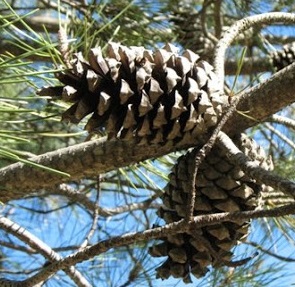SA Pine – Pinus spp.
Family – Pinaceae
Pinus pinaster is a pine native to the Mediterranean region. It is widely planted commercially in South Africa as a timber resource and for the forestry industry.
The Tree
This is a medium-size tree, reaching 20–35 m tall and with a trunk diameter of up to 1.2 
The bark is orange-red, thick and deeply fissured at the base of the trunk, somewhat thinner in the upper crown.
The leaves (‘needles’) are in pairs and very stout – 2mm broad, and up to 25cm long. The ‘needles’ are bluish-green to distinctly yellowish-green.

The pine tree species invade large areas and more specifically the fynbos vegetation. Fynbos vegetation is a fire-prone shrubland vegetation that is found in the southern and southwest Cape.
This tree produces resin which is a useful source of turpentine and rosin.
Properties
The pale coloured sapwood is clearly distinct from the pinkish-brown heartwood. The texture is relativ
The wood works reasonably well, planes to a smooth finish and nails well.
Using the Wood
Plantations supply important commercial resources in the form of timber for building, furniture and packaging, and pulp for paper products. As human populations grow, the demand for these products is driving substantial growth in plantation forestry. Such plantations are necessary both to meet demand for wood-based products and to protect remaining natural forests from over-exploitation.
Dry weight: 480 Kg / m3.
Source: Wikipedia
If you are looking to buy wood, please click here to visit our Timber slab sales page.
